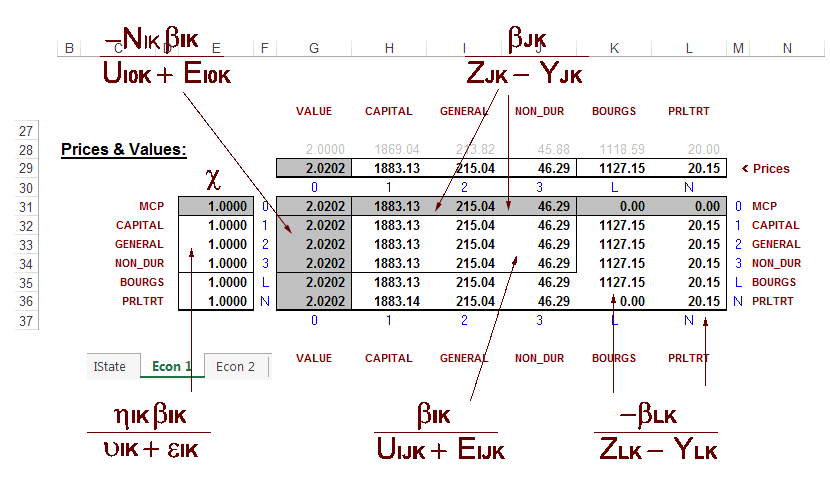The essentially neoclassical model set out to this point will not exhibit dynamic stability. It can continue a perfectly poised initial steady-state for centuries; it can faithfully reproduce responses to stimuli for decades; but it will ultimately dissolve into chaos. These deficiencies are instructive insofar as their correction requires some useful inquiries into the natures of money and financial control.
The figure below presents an instance of the desired end-state of economic adjustment in terms of SFEcon’s matrix structure. As envisioned by classical economists, each commodity J’s price equals its marginal cost of production, as well as its value of marginal product among all the sectors that use it.

Commodity J’s values of marginal product among the sectors IK, bIK/(UIJK+EIJK), appear in the body this matrix. Industrial sector’s marginal costs of production, bJK/(ZJK-YJK), are shown in row 0; and household sectors L’s marginal costs of production, -bLK/(ZLK-YLK), are shown on the diagonal. Currency equivalents of the sectors’ marginal values of value are computed in column 0. The sectors’ marginal values of money in terms of money cIK are in the vertical axillary vector:

For industrial sectors hIK is NIK+1, the number of IK’s inputs NIK plus 1. This count includes a bIK for each computation of IK’s values of marginal product, plus one more bIK to include computation of its marginal cost of production. Note that a household sector’s bLK enters the marginal cost of production computation as a negative, so households’ hLK is NLK-1.
Ultimate control of Model 0 will adjust the sectors’ valuations of money cIK toward money’s definitional spot price of unity. Industrial sectors will be shown to achieve this unity through financial intermediaries’ capital placements, which seek to maximize returns with respect to the sectors’ technical tradeoffs. Household sectors will be shown to achieve this same end by presenting utility functions expressive of their desired tradeoffs among work, leisure, and passive income.